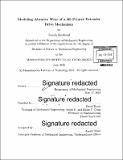| dc.contributor.advisor | David Hardt. | en_US |
| dc.contributor.author | Sandoval, Joseph (Joseph Alexander) | en_US |
| dc.contributor.other | Massachusetts Institute of Technology. Department of Mechanical Engineering. | en_US |
| dc.date.accessioned | 2016-12-05T19:57:30Z | |
| dc.date.available | 2016-12-05T19:57:30Z | |
| dc.date.copyright | 2016 | en_US |
| dc.date.issued | 2016 | en_US |
| dc.identifier.uri | http://hdl.handle.net/1721.1/105674 | |
| dc.description | Thesis: S.B., Massachusetts Institute of Technology, Department of Mechanical Engineering, 2016. | en_US |
| dc.description | Cataloged from PDF version of thesis. | en_US |
| dc.description | Includes bibliographical references (page 51). | en_US |
| dc.description.abstract | Additive manufacturing, more specifically 3D printing using fused filament fabrication (FFF), is a valuable technique; however, little has been done in developing a new mechanism for driving filament through the hot end of the 3D printer. This investigation focuses on a prototype extruder mechanism that utilizes two counter rotating motors to force filament through the nozzle. The plastic passes through the armateurs of the two motors and the oppositely-threaded shafts drive the filament while balancing each others torque. This design provides better protection against jamming of the nozzle. A bench top prototype was able to extrude filament at a rate much greater than traditional mechanisms allow, but the threads on the aluminum shafts wore down with very little use. An abrasive wear model of the extruder shafts was developed in order to determine the theoretical lifetime of the shafts given a certain material hardness. The wear rate of the shafts is proportional to the hardness of the material and the square of the velocity of the extruded filament. Based on this model as well as experiments done with various materials, it is estimated that steel shafts will have a lifetime that is 3 to 10 times longer than aluminum shafts. Still, this lifetime is still far too short for a part meant to be used 24/7. The wear on the threads of the shafts is so severe that no feasible material could survive an adequate lifetime before failure. | en_US |
| dc.description.statementofresponsibility | by Joseph Sandoval. | en_US |
| dc.format.extent | 51 pages | en_US |
| dc.language.iso | eng | en_US |
| dc.publisher | Massachusetts Institute of Technology | en_US |
| dc.rights | M.I.T. theses are protected by copyright. They may be viewed from this source for any purpose, but reproduction or distribution in any format is prohibited without written permission. See provided URL for inquiries about permission. | en_US |
| dc.rights.uri | http://dspace.mit.edu/handle/1721.1/7582 | en_US |
| dc.subject | Mechanical Engineering. | en_US |
| dc.title | Modeling abrasive wear of a 3D printer extruder drive mechanism | en_US |
| dc.title.alternative | Modeling abrasive wear of a 3-dimensional printer extruder drive mechanism | en_US |
| dc.title.alternative | Modeling abrasive wear of a three-dimensional printer extruder drive mechanism | en_US |
| dc.type | Thesis | en_US |
| dc.description.degree | S.B. | en_US |
| dc.contributor.department | Massachusetts Institute of Technology. Department of Mechanical Engineering | |
| dc.identifier.oclc | 964449245 | en_US |
